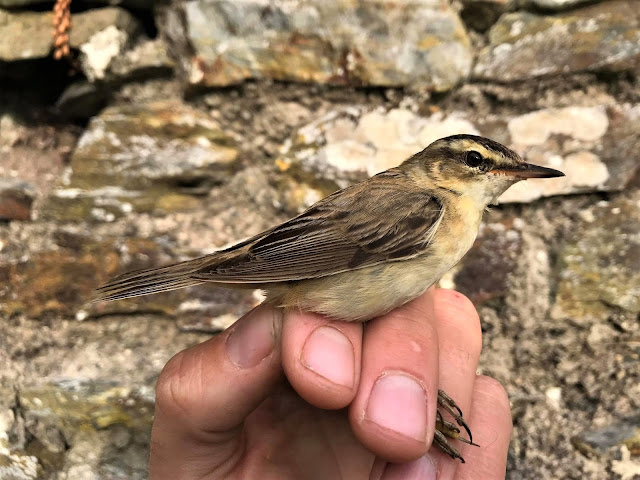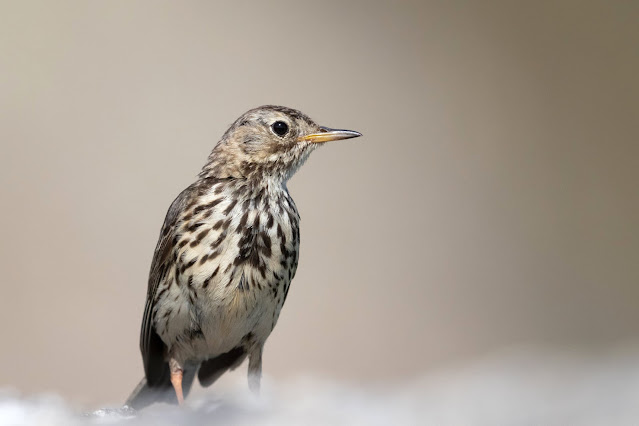In
the midst of a frantically busy summer season, Lundy Warden Dean Jones
has made the time to put together another compelling and evocative read
for blog aficionados, summing up the latter part of the breeding season
for most birds and the start of southbound migration, as well as sharing
the latest non-avian wildlife highlights from the island. Thanks Dean
for another fantastic round-up!
Weather-wise, the start of the period was mostly warm, dry and settled (max temp 26°C on 18th) with the winds being light and from the north up until the 17th when they shifted easterly until the 23rd. Things changed again come the 24th, when the weather became more unsettled and very wet. The next two days were then dry and calm before Storm Evert made his way across the Atlantic between the 28th & 30th, bringing with him lots of rain and strong winds (max 56mph gusts on 30th). Post-storm, things then became settled once again, particularly on the 3rd & 4th which were characterised by some lovely warm, sunny conditions, encouraging the first small emergence of flying ants across the island. This is always a very interesting time to be on Lundy, with the island's Herring and Lesser Black-backed Gulls taking to mimicking Swallows as they hawk for the aerial bonanza. It is always a great time for spotting pods of Common Dolphin close into shore too, as ants on the water’s surface encourage their fishy prey to move closer to shore. From the 5th the winds once again picked up, this time from the west, bringing with them spells of rain and mist which continued to the end of the period.
 |
| Sunset on flying ant day! 3 Aug © Dean Jones |
 |
| A Wheatear enjoys the evening light show from the lower Lighthouse Field wall, 3 Aug © Dean Jones |
Avian sightings of note included small numbers of Swift on 11 dates (max 16 on the 4th), singles of juvenile Cuckoo in various locations on the 25th, 27th, 28th, 29th & 2nd, a small movement of Woodpigeons was also noted at the end of July (max 12 on 27th), along with a few accompanying Collared Doves on the 23rd, 27th & 30th. Waders were also on the move with singles of Curlew on six dates, a lone Golden Plover on the 16th, singles of Snipe on the 3rd and 5th, two Green Sandpipers over the Village on the 23rd, and another at the bottom of Aztec Bay on the 26th. A Common Sandpiper dropped into the Landing Bay beach on the 7th, and a small number of Dunlin moved through on three dates – e.g. seven past Rat Island on the 5th.
Furthermore, the first juvenile Black-headed Gull of the autumn was present in the Landing Bay on the 21st, a young Cormorant flew over the island on the 25th, up to two Grey Herons have been present across eight dates, as well as up to six Kestrels hovering around the island each day – one of which was found eaten by a Peregrine along the Lower East Side Path on the 2nd.
On the passerine front, autumn hirundine passage has started to pick up, particularly with regard to Sand Martin (max 32 on the 4th) and Swallow (max 28 on the 5th). Warblers are trickling through most days too, including low single-digit counts of Chiffchaff, Sedge Warbler, Whitethroat and Blackcap, though Sedge Warbler reached a peak of 17 on the 9th.
Willow Warblers too are moving in low double-digit numbers each day, though the island has also seen a number of falls since the last blog post, e.g. 70 birds on 25th, a super 230 on 28th, 73 on 1st, and 210 on 9th.
On the passerine front, autumn hirundine passage has started to pick up, particularly with regard to Sand Martin (max 32 on the 4th) and Swallow (max 28 on the 5th). Warblers are trickling through most days too, including low single-digit counts of Chiffchaff, Sedge Warbler, Whitethroat and Blackcap, though Sedge Warbler reached a peak of 17 on the 9th.
Willow Warblers too are moving in low double-digit numbers each day, though the island has also seen a number of falls since the last blog post, e.g. 70 birds on 25th, a super 230 on 28th, 73 on 1st, and 210 on 9th.
 |
| Just one of the juvenile Willow Warbers with which the island was hopping on 28 Jul © Philip Lymbery |
 |
| Many Willow Warblers have also been caught and ringed over the last week or so, 3 Aug © Dean Jones |
 |
| Small numbers of Sedge Warblers have also been ringed, 3 Aug © Dean Jones |
Other birds of note included the first returning Garden Warbler in Millcombe on 2nd of August, singles of Song Thrush on 18th, 19th & 25th of July, and a smattering of Wheatear each day – including a count of 41 on the 4th. Additionally, species such as Linnet have seemingly had a great breeding season, with numerous three-figure counts throughout the period. Up to 34 Goldfinch have been present also and a single Lesser Redpoll flew over the Village on the 15th.
The title of star bird however was taken by a stunning summer-plumaged adult Little Grebe in the Landing Bay – a bird which was expertly found by Paul Holt and his family as they made their way down to the Jetty on the 30th. This is only the fifth record of this species for Lundy, the last of which was 21 years ago on July 26th 2000. Bravo Paul!
Other highlights have included a female/immature Marsh Harrier over Pondsbury on the 24th – a bird which has remained on the island and has been seen periodically up until the 9th. Additionally, an adult Hobby was logged hunting over Barton/St Helen’s Field on the 23rd, two Balearic Shearwaters (the first of the year) flew past Rat Island on the 7th, a lone Black-tailed Godwit flew south past Rat Island with three Oystercatchers on the 8th, and a noisy Wood Sandpiper flew low over the Jetty area/Rat Island on the 9th. The last record of Wood Sandpiper was, like the Little Grebe, in 2000, so more than two decades ago.
Finally, a stunning male Yellow Wagtail was foraging in St Helen’s Field on the 21st, and a female or immature Crossbill pitched down briefly into Millcombe pines on the 24th.
Out on the cliffs, things have become much quieter now with the departure of the island's breeding auks. Fulmar chicks are still occupying ledges, however, along with small numbers of young gulls, including a handful of Kittiwakes that are seemingly reluctant to fledge in both Aztec Bay and Jenny’s Cove. A visit to the Manx Shearwater nestboxes on the 4th revealed that all six of the incubating pairs recorded at the start of the season now have healthy young chicks inside. Five of these were still very much covered in fluffy grey down, though the chick in box D1 was much further along, looking more like an adult and thus probably thinking of fledging in the next week or so. How time flies!
 |
| One of the last Puffins of the season – all are now back out at sea for yet another year © Philip Lymbery |
On to the invertebrates! Highlights included the first Migrant Hawker dragonfly of the year at Quarter Wall on 1st August, a male Black-tailed Skimmer at Pondsbury on 2nd (only the second record for the island following a male on 30th June in the same location) and small numbers of Emperor Dragonfly, Common Darter, Blue-tailed Damselfly and Common Blue Damselfly most days.
There has also been a nice diversity of butterflies on the wing throughout – though all have been logged in relatively small numbers.
 |
| Clockwise from top left: Small Tortoiseshell, Small Copper, Red Admiral, Painted Lady, Five-spot Burnet moth, Meadow Brown, 3 Aug © Ben Arkless |
Other Lepidoptera of note have included three more new moth species for the island. These comprised the micro-moths Pseudargyrotoza conwagana and Gypsonoma dealbana found at 'Rüppell’s Quarry' (south of VC Quarry) on the 13th, and an Amphipoea species of macro-moth (commonly known as 'Ear' moths), which unfortunately could not be narrowed-down to species level without dissection (we decided to let the wee critter go!), in the Paradise Row Heath trap on 3rd August.
Additional moth records of note included the second record of White Plume – found by Alice Waterfield in the Tavern on 28th July – a species last recorded here in 1989. Bravo Alice! Another second record for Lundy was a Tawny Shears caught outside Paradise Row on the 3rd (previously recorded in 2012), along with singles of Silver Y, Rush Veneer and Dark Sword-grass.
A huge thank you to everyone who submitted sightings during this period: Liz Barrett, Chris & Sharron Blackmore, Janet Chik, Rosie Ellis, Eleanor Grover, Dean Jones, Philip & Helen Lymbery, Jackie, Nicole & Paul Holt, Alan & Sandra Smith, Sophie Smith, Matt Stritch, Adam Waters and Mark Webber.
I would also like to take this opportunity to say a huge thank you to Volunteer Assistant Warden Ben Arkless for all his hard work and top-class company during the past four months on the island. All the staff on Lundy are missing you already and sending you lots of luck and good vibes for your new venture on Brownsea Island! Thanks Ben!
A huge thank you to everyone who submitted sightings during this period: Liz Barrett, Chris & Sharron Blackmore, Janet Chik, Rosie Ellis, Eleanor Grover, Dean Jones, Philip & Helen Lymbery, Jackie, Nicole & Paul Holt, Alan & Sandra Smith, Sophie Smith, Matt Stritch, Adam Waters and Mark Webber.
I would also like to take this opportunity to say a huge thank you to Volunteer Assistant Warden Ben Arkless for all his hard work and top-class company during the past four months on the island. All the staff on Lundy are missing you already and sending you lots of luck and good vibes for your new venture on Brownsea Island! Thanks Ben!













